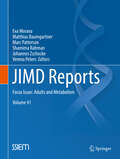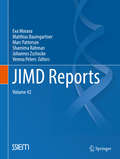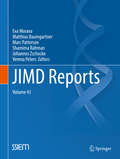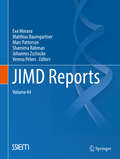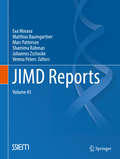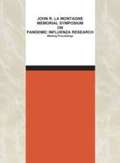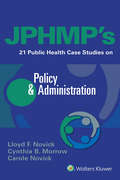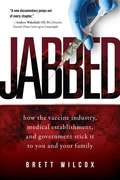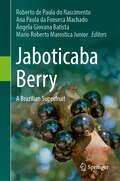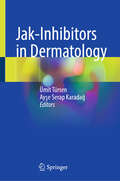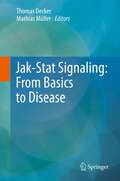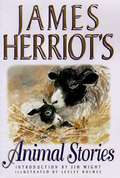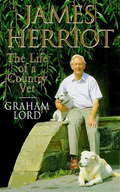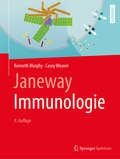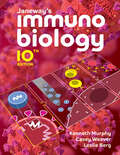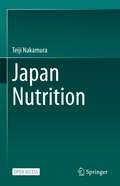- Table View
- List View
JIMD Reports, Volume 41: Focus Issue: Adults And Metabolism (Jimd Reports #41)
by Johannes Zschocke Eva Morava Verena Peters Matthias Baumgartner Marc Patterson Shamima RahmanJIMD Reports publishes case and short research reports in the area of inherited metabolic disorders. Case reports highlight some unusual or previously unrecorded feature relevant to the disorder, or serve as an important reminder of clinical or biochemical features of a Mendelian disorder.
JIMD Reports, Volume 42 (JIMD Reports #42)
by Johannes Zschocke Eva Morava Verena Peters Matthias Baumgartner Marc Patterson Shamima RahmanJIMD Reports publishes case and short research reports in the area of inherited metabolic disorders. Case reports highlight some unusual or previously unrecorded feature relevant to the disorder, or serve as an important reminder of clinical or biochemical features of a Mendelian disorder.
JIMD Reports, Volume 43 (JIMD Reports #43)
by Johannes Zschocke Eva Morava Verena Peters Matthias Baumgartner Marc Patterson Shamima RahmanJIMD Reports publishes case and short research reports in the area of inherited metabolic disorders. Case reports highlight some unusual or previously unrecorded feature relevant to the disorder, or serve as an important reminder of clinical or biochemical features of a Mendelian disorder.
JIMD Reports, Volume 44 (JIMD Reports #44)
by Johannes Zschocke Eva Morava Verena Peters Matthias Baumgartner Marc Patterson Shamima RahmanJIMD Reports publishes case and short research reports in the area of inherited metabolic disorders. Case reports highlight some unusual or previously unrecorded feature relevant to the disorder, or serve as an important reminder of clinical or biochemical features of a Mendelian disorder.
JIMD Reports, Volume 45 (JIMD Reports #45)
by Johannes Zschocke Eva Morava Verena Peters Matthias Baumgartner Marc Patterson Shamima RahmanJIMD Reports publishes case and short research reports in the area of inherited metabolic disorders. Case reports highlight some unusual or previously unrecorded feature relevant to the disorder, or serve as an important reminder of clinical or biochemical features of a Mendelian disorder.
JOHN R. LA MONTAGNE MEMORIAL SYMPOSIUM ON PANDEMIC INFLUENZA RESEARCH: Meeting Proceedings
by National Research Council of the National AcademiesThe National Academies Press (NAP)--publisher for the National Academies--publishes more than 200 books a year offering the most authoritative views, definitive information, and groundbreaking recommendations on a wide range of topics in science, engineering, and health. Our books are unique in that they are authored by the nation's leading experts in every scientific field.
JPHMP's 21 Public Health Case Studies on Policy & Administration
by Lloyd NovickJPHMP's 21 Public Health Case Studies on Policy & Administration, compiled by the founding editor and current editor-in-chief of the Journal of Public Health Management and Practice, provides you with real-life examples of how to strategize and execute policies and practices when confronted with issues such as disease containment, emergency preparedness, and organizational, management, and administrative problems.
Jabbed: How the Vaccine Industry, Medical Establishment, and Government Stick It to You and Your Family
by Brett WilcoxJabbed demonstrates that the medical procedure hailed as the greatest medical advancement in history—vaccines—is a racket run by criminals and gullible believers who have replaced vaccine science with the religion of vaccinology. Vaccine marketers teach believers to fear, shame, and scapegoat anyone foolish enough to question the sanctity of vaccines. Such an environment is not the domain of science; rather it’s the breeding ground of tyranny.Jabbed exposes this tyranny. From polio and smallpox to medical journals, medical curricula, congressional hearings, regulatory policies, White House statements, and executive orders, Jabbed shines light on the dark underbelly of Big Pharma, Big Medicine, and Big Government.A vaccine informed public is the only thing that will have the power to stop vaccine industry sociopaths and to hold them accountable for their crimes.Jabbed informs and immunizes against three of the most dangerous epidemics in history: tyranny, greed, and corruption. Once immunized, the growing vaccine-informed community will have the power to stand up and dismantle the vaccine paradigm and program and to punish the perpetrators of what may well be the greatest medical fraud ever perpetrated on the human race: vaccines.
Jaboticaba Berry: A Brazilian Superfruit
by Roberto de Paula do Nascimento Ana Paula da Fonseca Machado Ângela Giovana Batista Mario Roberto Marostica JuniorJaboticaba Berry (Plinia spp.), a native fruit from the Brazilian Atlantic Forest, has been associated with several benefits for the prevention or therapy of chronic diseases due to its promising set-up of antioxidants and nutrients. Jaboticaba shows a distinguished amount of bioactive compounds when compared to other popular berries, which instigates great interest in pharmaceutical and food usage. The many parts of the berry, but especially the seed and peel by-products, are rich in dietary fibers and phenolic compounds and therefore have been able to counteract the negative implications of obesity, diabetes, inflammation, hepatic complications, and cancers, as shown by experimental studies. The development of new products and alternative therapies calls for the understanding of jaboticaba’s history, occurrence, morphology, nutritional and chemical composition, and industrial usage potential, reunited in this book. Well-founded and cutting-edge Jaboticaba berry: A Brazilian superfruit aims to instigate and inspire researchers, health and academic professionals, food and pharmaceutical scientists, educators, students, and all of those interested in natural products, herbal medicine, innovative alternative therapies, and sustainable use of by-products.
Jahresabschluss, Kostenrechnung und Finanzierung im Krankenhaus: Grundlagen und Zusammenhänge verstehen
by Gerald SchmolaDer Jahresabschluss, die Kostenrechnung sowie die Finanzierung im Krankenhaussektor sind für Nicht-Ökonomen oftmals sehr komplex und kaum zu durchschauen. Insbesondere leitende Ärzte und Pflegekräfte, Betriebs- und Personalräte oder aber auch Quereinsteiger im Krankenhausbereich finden kaum kompakte und verständliche Darstellungen der Zahlenwelt eines Krankenhauses. Das vorliegende Buch schließt diese Lücke: Es gibt eine allgemeine Einführung in die Themenfelder und geht zudem auf die Besonderheiten des Jahresabschlusses, der Kostenrechnung sowie der Finanzierung von Kliniken ein. Der Leser kann sich durch Selbst-Studium die wichtigsten Grundlagen zur Finanzierung im Krankenhaus aneignen, sodass eine fachliche Diskussion mit Betriebswirten in Gesundheitseinrichtungen möglich wird. Das Werk richtet sich auch an Bachelorstudierende mit Bezug zum Gesundheitswesen sowie an Teilnehmer von MBA-Programmen für Nicht-Betriebswirte.
Jak-Inhibitors in Dermatology
by Ayşe Serap Karadağ Ümit TürsenThis book covers the clinical usage of JAK inhibitors, which target Janus kinases and have shown promising results in the treatment of various dermatologic conditions, including atopic dermatitis, psoriasis, vitiligo, connective tissue disorders, autoimmune bullous diseases and alopecia areata. It is likely that JAK inhibitors will continue to play an important role in the management of these conditions, with clinical trials ongoing to assess their safety and efficacy in the treatment of other dermatologic disorders, such as vitiligo and hidradenitis suppurativa. However, it is important to note that JAK inhibitors can have potential side effects, including increased risk of infections, anemia and thrombosis. Therefore, careful monitoring of patients receiving JAK inhibitors is necessary to ensure their safety.Jak Inhibitors in Dermatology represents a treatise on this novel topic and discusses that while JAK inhibitors have shown great promise in the treatment of various dermatologic conditions, further research and monitoring is necessary to fully understand their potential benefits and risks. This book is therefore of great interest for all dermatologists as a first step to understanding this novel treatment.
Jak-Stat Signaling: From Basics to Disease
by Mathias Müller Thomas DeckerJAK tyrosine kinases and STAT transcription factors constitute a signaling pathway, which is activated by cytokines. By activating gene transcription it regulates essential biological responses to environmental cues. The Jak-Stat pathway is involved in the regulation of cell development, differentiation, proliferation and apoptosis. Improper function may contribute to hematopoietic malignancies and cancer. This book provides comprehensive insights into the latest basic and clinical developments in the field. The first part reviews recent findings and new technologies pertaining to basics of Jak-Stat function. The second part describes the evolution of Jak-Stat signaling and the role of the pathway in invertebrate organisms. The third part focuses on Jak-Stat signaling in hematopoietic cells under both physiological and pathophysiological conditions. Finally, chapters in the fourth section describe the relationship of Jak-Stat signaling to various states of disease, particularly infection, leukemias and solid cancers. The book is intended for all scientists in molecular biology, biochemistry and cell biology dealing with biomedical issues.
James Cowles Prichard of the Red Lodge: A Life of Science during the Age of Improvement (Critical Studies in the History of Anthropology)
by Margaret M. CrumpMargaret M. Crump offers the first thorough biography of British scientist and physician James Cowles Prichard (1786–1848), an intellectual giant in the developing human sciences, a pioneering psychiatric theorist, and Europe&’s leading anthropologist during the first half of the nineteenth century.
James Herriot's Animal Stories
by James HerriotFew authors in memory have delighted readers around the world thoroughly as the beloved veterinarian James Herriot. And, with his recent volumes of hugely popular illustrated tales—James Herriot's Cat Stories and James Herriot's Favorite Dog Stories—his name has been introduced to a whole new generation of readers. Now, this gorgeous new collection finally brings together ten of his best-loved stories celebrating all the creatures in his wonderful world—creatures bright and beautiful, great and small. Here are lambs, horses, cows, dogs, even a whimsical pig or two, along with their colorful human counterparts—all brought vividly to life by Herriot's storytelling magic. From a prickly horse young James encountered early in his veterinary-school experience, through Dorothy the goat—star of the entrancing holiday tale "There's Christmas—and Christmas"—we are reacquainted with all the charming companions of Herriot's Yorkshire menagerie. Once again illuminated by the radiant watercolors of Lesley Holmes, each of Herriot's animal friends is rendered with the kind of warmth and humor that comes with old, familiar friendship. With a special introduction by Herriot's own son Jim, the stories in this bright new collection will warm readers of every age.
James Herriot's Cat Stories
by James HerriotKittens and cats of all kinds abound in this book and, like their flesh-and-blood counterparts, they will purr their way into the hearts and minds of everyone who hears their stories. This warm and joyful volume of stories collects some of the Yorkshire vet's favorite tales about one of his favorite animals―each memoir as memorable and heartwarming as the last.
James Herriot: The Life Of A Country Vet
by Graham LordLord writes a revealing and affectionate biography of the remarkable veterinarian and beloved author who enlightened readers with All Things Bright and Beautiful and All Creatures Great and Small.
James Herriot: The Life of a Country Vet
by Graham LordAlf Wight, a modest Scottish writer, better known as James Herriot, wrote books that became worldwide best sellers, films, audiobooks, and a much-loved television show. In The Life of a Country Vet, Graham Lord has written a detailed and affectionate biography of this remarkable man. Lord carefully documents Wight's life, beginning with his childhood in Glasgow and his years in veterinary college. Following his development as a writer, the source of his pen name, and his struggles to get published. Along the way, we encounter some extraordinary events and hidden tragedies in this seemingly magical life. Millions of fans laughed and cried at Wight's delightful stories of life as a vet. Lord reveals that some of the stories were utterly true, and some were utterly fictional. He illuminates the real relationships between the memorable characters that inhabit the books. This warm yet insightful portrait by Lord - who knew his subject very well - will be enjoyed by Wight's myriad of fans. It also dispels the myths that have grown around the life of one of the most famous and deeply loved vets the world has known.
James Herriot: The Life of a Country Vet
by Graham LordAlf Wight, a modest Scottish writer, better known as James Herriot, wrote books that became worldwide best sellers, films, audiobooks, and a much-loved television show. In The Life of a Country Vet, Graham Lord has written a detailed and affectionate biography of this remarkable man. Lord carefully documents Wight's life, beginning with his childhood in Glasgow and his years in veterinary college. Following his development as a writer, the source of his pen name, and his struggles to get published. Along the way, we encounter some extraordinary events and hidden tragedies in this seemingly magical life. Millions of fans laughed and cried at Wight's delightful stories of life as a vet. Lord reveals that some of the stories were utterly true, and some were utterly fictional. He illuminates the real relationships between the memorable characters that inhabit the books. This warm yet insightful portrait by Lord - who knew his subject very well - will be enjoyed by Wight's myriad of fans. It also dispels the myths that have grown around the life of one of the most famous and deeply loved vets the world has known.
Jan Gösta Waldenström and His World: The Life and Work of a Giant in Science, Medicine and Humanity (Springer Biographies)
by Frank WollheimJan Waldenström (1906-1996) was the leading Swedish internist of the twentieth century. The first chapter of the book presents his remarkable family including five generations of physicians. Born in Stockholm, we follow JW to medical school at Uppsala University during 1924–33. In 1934–5, he spent a year in the laboratory of Nobel Laureate Hans Fischer in Munich. In 1937, he defended a landmark thesis on acute intermittent porphyria. As “Docent” (assistant professor) in Uppsala, he discovered two new diseases in 1943. In 1944–5, he spent 7 months in the US commissioned by the Swedish Health Board. This started friendships with leading colleagues and scientists. With time, JW fostered a worldwide network of contacts and became a most influential international star. But this was just the beginning. The book follows Waldenström's remarkable career including his description of chronic active hepatitis as a new disease, his introduction of nuclear medicine in Sweden, his pioneering of the concept of the concept of poly- and monoclonal gammopathies, and many more highly significant achievements. His legacy is emphasized by Waldenström lectures, Waldenström Prizes, and by the International Waldenström’s Macroglobulinemia Foundation, IWMF, and the Bing Center for Waldenström’s macroglobulinemia at the Dana Farber Institute of Cancer Institute of the Harvard University in Boston. And now, not least, by this comprehensive biography.
Jan de Vries: A Life in Healing
by Jan de VriesJan de Vries: A Life in Healing is the complete life story of the world-renowned health guru. It recounts his journey from childhood in wartime Holland through an amazing 50-year career, during which he has earned a global reputation as a leader in the field of alternative medicine.De Vries has encountered many obstacles in his fight to achieve recognition for the benefits of alternative medicine and he was once even threatened with imprisonment. Throughout these struggles he has remained true to his principles and his success can be measured by the large number of conventional doctors who have come to support his work.In this extraordinary autobiography, de Vries also looks back over his long and fruitful working relationship with Alfred Vogel, the famous Swiss naturopath. De Vries was the only person to whom Vogel taught his unique healing methods and he shares many of the secrets and methods he learned from this remarkable man.Jan de Vries has helped hundreds of thousands of patients during his long career and in this absorbing account he includes invaluable advice for daily living and achieving good physical, mental and spiritual health.
Jan's Story
by Katie Couric Barry PetersenWhen CBS News Correspondent Barry Petersen married the love of his life twenty-five years ago, he never thought his vow, "until death do us part," would have an expiration date. But Early Onset Alzheimer's claimed Jan Petersen, Barry's beautiful wife, at 55, leaving her unable to remember Barry or their life together.
Janeway Immunologie
by Kenneth Murphy Casey Weaver Lothar SeidlerJetzt wieder auf dem neuesten Stand: DIE Einführung in die Immunologie für Studierende der Biowissenschaften und der MedizinDer Janeway, das bewährte und viel gelobte Standardlehrbuch der Immunologie, liegt nun erneut in einer vollständig überarbeiteten und aktualisierten Fassung vor. Das Werk führt den Leser in gewohnter Souveränität durch alle Aspekte des Immunsystems – vom ersten Einsatz der angeborenen Immunität bis zur Erzeugung der adaptiven Immunantwort, von den vielfältigen klinischen Konsequenzen normaler und pathologischer immunologischer Reaktionen bis zur Evolution des Immunsystems.In der 9. Auflage sind unter anderem neue Erkenntnisse zur modularen Immunantwort, zur Klassenwechsel-Rekombination, zur Vielfalt der CD4-T-Zellen, zu Chemokin-Netzwerken, zur Umgehung der Immunabwehr durch Pathogene und zur Immuntherapie von Krebs integriert. Zahlreiche neue Abbildungen veranschaulichen die im Text erläuterten Prozesse und Konzepte. Der umfangreiche Anhang zu den Methoden der Immunologie ist um etliche neue Techniken erweitert worden. Zudem wurden die Verständnisfragen an den Kapitelenden komplett überarbeitet. Das in zahlreiche Sprachen übersetzte Werk besticht durch seine Aktualität, seine konzeptionelle Geschlossenheit und seine ansprechende Illustration. Es bleibt damit in diesem unverändert rasant fortschreitenden Fachgebiet ein hochaktueller und verlässlicher Begleiter.Stimmen zu früheren Auflagen:Dieses Buch bringt Studenten und Wissenschaftlern die Immunologie aktuell und in hervorragender Weise näher. Prof. Dr. Nikolaus Müller-Lantzsch, Universitätskliniken HomburgDie neue Auflage ist kaum noch zu schlagen. Prof. Dr. Stefan H.E. Kaufmann, Max-Planck-Institut für Infektionsbiologie, BerlinHervorragend. Dieses Lehrbuch genügt sämtlichen Ansprüchen! Prof. Dr. Andreas Dotzauer, Uni BremenDas Buch besticht durch die hervorragende Vermittlung von Grundlagenwissen, das es in weiterer Folge ermöglicht, auch die komplexen Zusammenhänge bei klinisch-immunologischen Fragestellungen zu verstehen. Prof. Dr. Wolfgang Sipos, Medizinische Universitätsklinik WienDie auf das wesentliche reduzierten graphischen Darstellungen haben einen besonderen didaktischen Wert, vor allem angesichts der Komplexität dieses Fachgebiets. Prof. Dr. Arne Skerra, TU MünchenUnter den Immunologie-Lehrbüchern nimmt dieses sicher heute den vorderen Rang ein. Es macht Vergnügen, sich von ihm bilden zu lassen. BiospektrumAlles in allem ein wunderbar gestaltetes, umfassendes Lehrbuch, dessen Schwerpunkt deutlich auf der Erklärung grundlegender Mechanismen der Immunabwehr liegt. Naturwissenschaftliche RundschauDas Buch ist didaktisch hervorragend, vor allem auch in den Abbildungen, und bietet am Ende der Kapitel prägnante Zusammenfassungen, Fragen zum Überprüfen des Gelernten und Hinweise auf Originalarbeiten. Pharmazie in unserer Zeit Uneingeschränkt empfehlenswert; es eignet sich besonders für Biologiestudenten zur Prüfungsvorbereitung, für Mediziner als Nachschlagewerk, aber auch für Studenten und Dozenten anderer Fächer. Chirurgische PraxisDieses packende moderne Lehrbuch [bietet] jungen Biologen und Medizinern die gegenwärtig beste Möglichkeit, die Mechanismen des Immunsystems in ihrem evolutionären und funktionellen Kontext und medizinischen Bezug kennen zu lernen und vielleicht für ihre eigene zukünftige Tätigkeit zu entdecken. Prof. Dr. Klaus Rajewsky im Vorwort zur 5. Auflage
Janeway's Immunobiology (Tenth Edition)
by Casey Weaver Kenneth M. Murphy Leslie J. BergThe gold standard, with the most up-to-date research and resources Immunobiology is the premier text for immunology at the advanced undergraduate, graduate, and medical school levels. Beginning students appreciate the book’s clear writing and informative illustrations, while advanced students and working immunologists value its comprehensive scope. Every chapter is reviewed with experts to ensure accuracy, authority, currency, and depth. The Tenth Edition is supported by InQuizitive, Norton’s award-winning, easy-to-use adaptive learning tool that helps students learn immunological terms and apply them conceptually. This purchase offers access to the digital ebook only.
January First: A Child's Descent into Madness and Her Father's Struggle to Save Her
by Michael SchofieldMichael Schofield's daughter January is at the mercy of her imaginary friends, except they aren't the imaginary friends that most young children have; they are hallucinations. And January is caught in the conflict between our world and their world, a place she calls Calalini. Some of these hallucinations, like "24 Hours," are friendly and some, like "400 the Cat" and "Wednesday the Rat," bite and scratch her until she does what they want. They often tell her to scream at strangers, jump out of buildings, and attack her baby brother. At six years old, January Schofield, "Janni," to her family, was diagnosed with schizophrenia, one of the worst mental illnesses known to man. What's more, schizophrenia is 20 to 30 times more severe in children than in adults and in January's case, doctors say, she is hallucinating 95 percent of the time that she is awake. Potent psychiatric drugs that would level most adults barely faze her. January First captures Michael and his family's remarkable story in a narrative that forges new territory within books about mental illness. In the beginning, readers see Janni's incredible early potential: her brilliance, and savant-like ability to learn extremely abstract concepts. Next, they witnesses early warning signs that something is not right, Michael's attempts to rationalize what's happening, and his descent alongside his daughter into the abyss of schizophrenia. Their battle has included a two-year search for answers, countless medications and hospitalizations, allegations of abuse, despair that almost broke their family apart and, finally, victories against the illness and a new faith that they can create a life for Janni filled with moments of happiness. A compelling, unsparing and passionate account, January First vividly details Schofield's commitment to bring his daughter back from the edge of insanity. It is a father's soul-baring memoir of the daily struggles and challenges he and his wife face as they do everything they can to help Janni while trying to keep their family together. From the Hardcover edition.
Japan Nutrition
by Teiji NakamuraThis Open Access auto-translation book demonstrates a time series of nutrition improvement in Japan since the introduction of nutrition sciences to Japan about 150 years ago. The chapters present the historical event where nutritional deficiency due to food shortage was improved in almost a century, by the introduction of nutrition policy and practices such as the "Nutrition Improvement Law". The book contributed to the construction of a longevity nation by resolving the double burden of malnutrition, which is a mixture of undernutrition and overnutrition and creating a social environment in which sustainable healthy diets can be accessed.This publication is designed mainly for nutrition specialists, nutritionists, nutrition administrators, medical doctors, pharmacists, nurses, physiotherapists, nutrition educators, cookers, nutrition volunteers, health and nutrition food developers, school lunch managers, and etc. Furthermore, students studying nutrition, teachers involved in the education and training of dietitians, and general consumers who are interested in nutrition, diets, and how to improve malnutrition, will find this book useful.Through this book, dietitians, nutrition volunteers, and consumers engaged in nutrition improvement can understand the significance of nutrition improvement and know specific methods. Young nutritionists who will study and research nutrition can learn the importance of nutrition and take pride in nutrition research. The government official who implements nutrition policy can know the concrete method of nutrition policy.Today, people around the world understand the importance of nutrition and are gaining international interest. However, malnutrition has not improved as much as expected. This book is an interesting way for everyone involved in nutrition to learn how to eradicate malnutrition from the world. The translation was done with the help of artificial intelligence (machine translation by the service DeepL.com). The present version has been revised technically and linguistically by the author in collaboration with Professor Emeritus Dr. Andrew R. Durkin of Indiana University.
